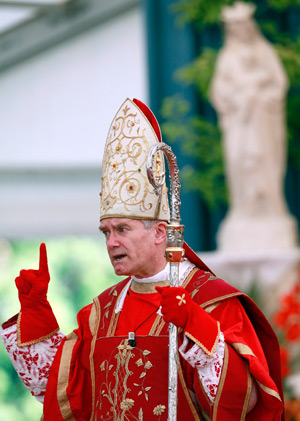
VATICAN CITY (CNS) — Hinting at a willingness to continue discussions with the Vatican and recognizing the full authority of the pope over the church, the traditionalist Society of St. Pius X said it must defend church teaching from error.
“As for all the novelties of the Second Vatican Council, which remain tainted with errors, and for the reforms derived from it,” the statement said, “the society can only continue to uphold the affirmations and teachings of the constant magisterium of the church.”
The statement from the society’s general chapter meeting, which ended July 14, was posted in French, Italian, English, German and Spanish on the society’s website July 19.
Chapter participants “determined and approved the necessary conditions” for an eventual, full reconciliation with the Vatican, it said. If the conditions are met, “an extraordinary chapter with deliberative vote will be convened.”
The website said the statement had been sent to the Vatican prior to publication.
Jesuit Father Federico Lombardi, Vatican spokesman, said the Vatican does not consider the statement to be “a formal response” by the SSPX to the last document it asked Bishop Bernard Fellay, the society’s superior general, to sign.
Because “we do not consider it — and it is not — a formal response,” Father Lombardi said, the Vatican would not comment on the statement’s content.
“The Holy See has taken note of this declaration, but awaits the forthcoming official communication” of the society as its “dialogue with the Pontifical Commission ‘Ecclesia Dei’ continues,” he said. “Ecclesia Dei,” now headed by U.S. Archbishop J. Augustine Di Noia, is handling the discussions with the SSPX under the guidance of the Congregation for the Doctrine of the Faith.
The SSPX statement said members of the general chapter believe “the paramount duty of the society, in the service which it intends to offer to the church, is to continue with God’s help to profess the Catholic faith in all its purity and integrity with a determination matching the intensity of the constant attacks to which this very faith is subject nowadays.”
Chapter members formally affirmed their faith in the Roman Catholic Church and its hierarchical structure in which “the supreme power of government over the universal church belongs only to the pope, vicar of Christ on earth.”
At the same time, members said they would continue to seek guidance from the “constant tradition of the church” as they await “the day when an open and serious debate will be possible which may allow the return to tradition of the ecclesiastical authorities.”
Ending with a prayer, the statement asked Mary “to chase the enemies out from inside the church,” saying some inside the church “are trying to destroy it more radically than its enemies from outside.”
Pope Benedict XVI launched a new series of doctrinal discussions with the SSPX in 2009, lifting excommunications imposed on its four bishops, who were ordained in 1988 without papal approval, and expressing his hopes they would return to full communion with the church.
As the discussions progressed, the Vatican gave SSPX leaders a “doctrinal preamble” to sign. The Vatican said the document, which has not been published, outlines principles and criteria necessary to guarantee fidelity to the church and its teaching.
When it appeared Bishop Fellay was close to signing an agreement with the Vatican, internal tensions within the SSPX erupted. The statement from the general chapter said that during the July meeting, the SSPX leaders recovered their “profound unity.”






